Foram encontradas 70 questões.
Cane surpasses power dams in Brazil energy complex
Thu May 8, 2008 2:41pm EDT
By Denise Luna
RIO DE JANEIRO (Reuters) - Sugar cane and cane-based ethanol became a more important energy source than hydroelectric power plants in Brazil’s overall energy complex last year, topped only by petroleum and oil products.
The government’s EPE energy planning agency said on Thursday sugar cane had a 16 percent share in the country’s so-called energy matrix — a combination of all sources of energy including fuels and electricity — while power dams were left behind with a 14.7 percent share.
Oil and derivatives had a 36.7 percent weighting, dropping from 37.8 percent in 2006. “It’s a historic year in that sense, it’s an irreversible trend,” EPE President Mauricio Tolmasquim told reporters. He attributed the growing role of sugar cane to booming demand for ethanol as a motor fuel, but expected more cane and ethanol to be used for electricity generation as well.
Brazil is a world leader in biofuels with decades of valuable expertise in using ethanol in cars.
In February 2007, the consumption of ethanol surpassed that of gasoline for the first time in two decades. The trend is driven by a drop in ethanol prices and huge sales of flex-fuel cars that can run on ethanol, gasoline or any mix of the two.
Hydrous ethanol consumption jumped 46 percent last year to 10.4 billion liters, while the usage of anhydrous ethanol that is mostly blended into gasoline sold in Brazil rose nearly 20 percent to 6.2 billion liters, EPE said. At the same time, gasoline consumption in the country dipped almost 4 percent to 18 billion liters.
Tolmasquim said it was important that Latin America’s largest country was self-sufficient in the three main sources of energy, including oil. Brazil met its oil needs with domestic output for the first time in 2006.
It still needs to import some light crude to mix with heavy local crudes for refining, but it also exports heavy oil. Last year’s exports totaled an average of 421,000 barrels per day and imports stood at 418,000 bpd.
All nonrenewable energy’s share fell to 53.6 percent in the overall complex in 2007 from 55.1 percent in 2006, with coal gaining some ground on its increased use in steelmaking. Nuclear energy’s share was just 1.4 percent.
Renewables, which include hydroelectricity, ethanol and plant-based biodiesel, gained to a 46.4 percent weighting from 44.9 percent. The use of renewable energy sources in Brazil by far surpasses the world’s average of around 13 percent, EPE said.
(Writing by Andrei Khalip; Editing by Christian Wiessner) Disponível em: <http://www.reuters.com/article/businessNews/idUSN0838471920080508?feedType=RSS&feedName=businessNews>
The fragment “The use of renewable energy sources in Brazil by far surpasses the world’s average of around 13 percent,” means that Brazil
Provas
Brazil is one of the largest producers of ethanol in the world and is the largest exporter of the fuel. In 2006, Brazil produced 308,000 bbl/d of ethanol. It is predicted that Brazil’s ethanol production will reach 329,000 bbl/d in 2007 and 365,000 bbl/d in 2008, as over half of all cars in the country are of the flex-fuel variety and all gasoline in Brazil contains ethanol. Ethanol in Brazil comes from sugar cane, which prospers in the country’s tropical climate.
In recent years, Brazil has tried to increase ethanol exports, especially to the United States. In 2006, Brazil exported 29,600 bbl/d of ethanol to the United States, quadruple the amount exported to the U.S. in 2005. To help facilitate additional exports, Petrobras announced a plan in early 2006 to build an ethanol pipeline from Goias, an interior area at the center of Brazil’s sugarcane production, to Sao Paulo. However, increasing domestic demand and high domestic prices may limit export growth. In addition, Brazil’s ethanol exports face high tariffs in some markets, such as the 54 cent per gallon tariff in the United States.
Energy Information Administration extracted from: http://www.eia.doe.gov/emeu/cabs/Brazil/Oil.html
According to Paragraph 2 in the text, Brazilian exports of canebased ethanol
Provas
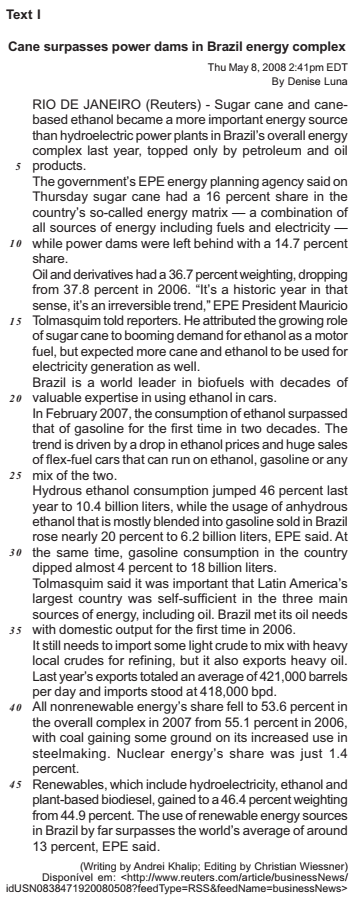
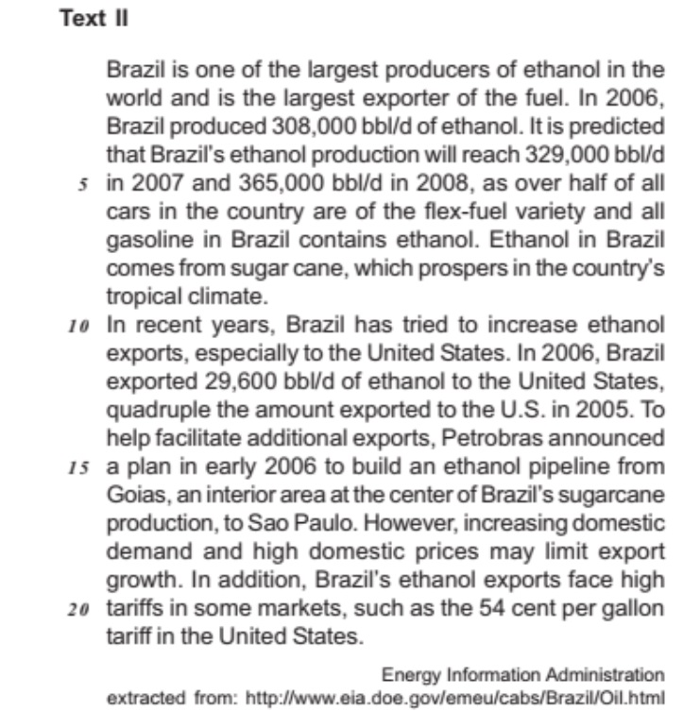
Comparing Text I and Text II, it is correct to say that
Provas
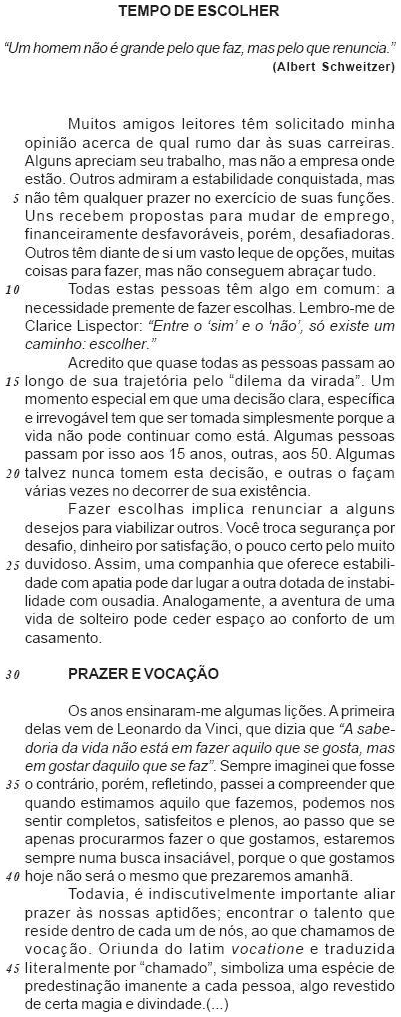
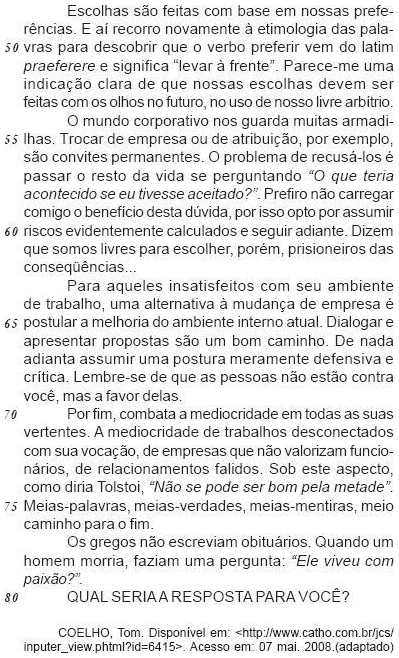
Provas
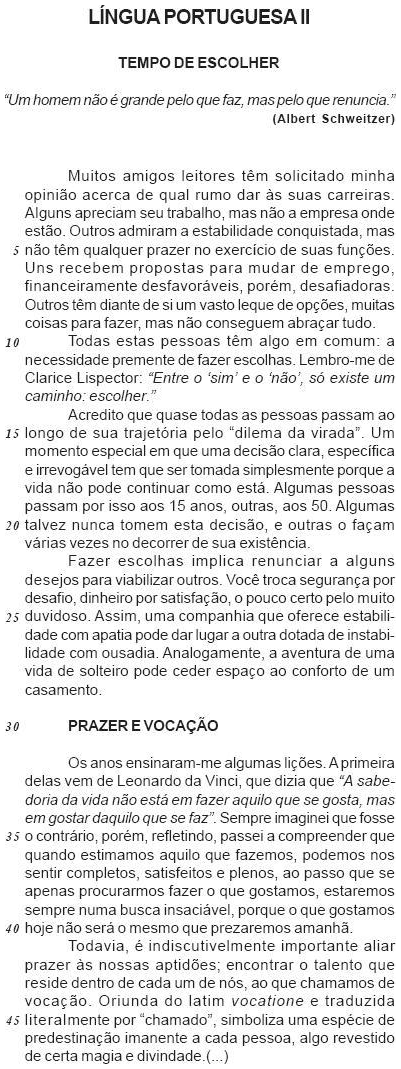
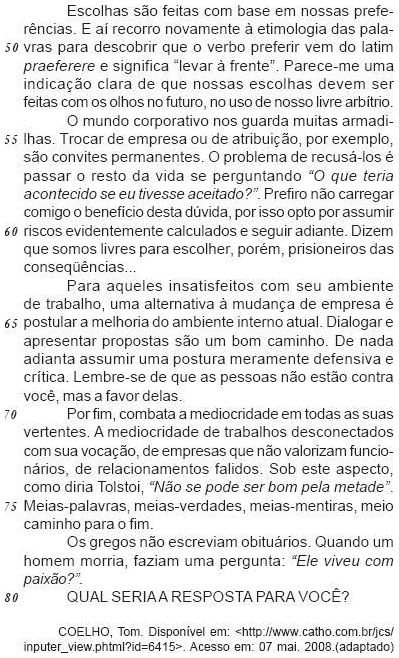
Provas
Disciplina: Engenharia Ambiental e Sanitária
Banca: CESGRANRIO
Orgão: Petrobrás
A infiltração é o fenômeno de penetração da água nas camadas de solo próximas à superfície do terreno, movendo-se para baixo, através de vazios, sob a ação da gravidade, até atingir uma camada-suporte, que a retém, formando então a água do solo. Entre as grandezas características da infiltração tem-se que o(a)
Provas
Disciplina: Engenharia Ambiental e Sanitária
Banca: CESGRANRIO
Orgão: Petrobrás
Atualmente, os administradores têm lançado mão de ferramentas de auxílio ao planejamento e à gestão do meio ambiente. Entre estas ferramentas encontram-se os instrumentos econômicos e os de comando e controle, que podem ser exemplificados, respectivamente, por
Provas
A Lei nº 6.938/81 e suas posteriores alterações pela Lei nº 7.804/89 e pela Lei nº 8.028/90 estabeleceram a Política Nacional do Meio Ambiente, fixando princípios, objetivos e instrumentos. NÃO constitui um desses instrumentos o(a)
Provas
Disciplina: Engenharia Ambiental e Sanitária
Banca: CESGRANRIO
Orgão: Petrobrás
Na economia ambiental, o valor econômico total é calculado pelo somatório do valor de uso, do valor de opção e do valor de existência. Sobre estes valores pode-se afirmar que:
I - o cálculo do valor econômico total não consegue resolver o problema da incerteza, pois o futuro é, na realidade, desconhecido, tornando impossível conhecer o preço real de algum bem num futuro longínquo.
II - o valor de uso é aquele que é dado pelas pessoas para o recurso visando a um uso futuro, seja pelas próprias pessoas ou pelas gerações seguintes.
III - o valor da água de um poço subterrâneo decorrente de sua captação e consumo para abastecimento é um exemplo do valor de uso indireto deste recurso.
IV- o valor de existência é aquele em que o benefício atual do recurso deriva das funções ecossistêmicas, como a parcela de estabilidade climática decorrente da preservação de florestas.
Está(ão) correta(s) APENAS a(s) afirmação(ões)
Provas
Disciplina: Engenharia Ambiental e Sanitária
Banca: CESGRANRIO
Orgão: Petrobrás
Na avaliação do uso de recursos naturais, o uso da água pode ser classificado em consuntivo ou não-consuntivo. Representam, respectivamente, um uso consuntivo e um uso não consuntivo:
Provas
Caderno Container